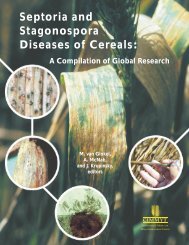Section 3 (Crop Management)
Section 3 (Crop Management)
Section 3 (Crop Management)
You also want an ePaper? Increase the reach of your titles
YUMPU automatically turns print PDFs into web optimized ePapers that Google loves.
Soil fertility in the hills of Nepal<br />
significantly less than the rate of adoption of fertilizer. These results are somewhat surprising given the<br />
relatively higher cost of fertilizer compared to seed and the additional difficulty of transporting bulky<br />
fertilizer.<br />
The logit model used to determine factors affecting the adoption of fertilizer was significant at 1%<br />
level of significance based on likelihood ratio (Table 3). Goodness of fit, which is generally measured by<br />
Pseudo R2 in such model, was 0.43. The result shows that the farmers in Dolakha (eastern hills) have<br />
high probability of using fertilizer than in Dailekh (western hills). The other variables that contribute in<br />
the adoption of fertilizer are access to the market, literacy of head of the household, number of years one<br />
is cultivating improved OPVs, number of economically active (labor force) members in the household<br />
and size of Khet land (rice field). Number of livestock holding (availability of manure) has negative<br />
impact on adoption of fertilizer as manure is a good substitute of fertilizer in the hills. Income from sales<br />
of crops and contact with extension people contribute adoption of fertilizer positively but the coefficients<br />
associated with those variables failed to be significant (Table 3). Hiring of labor for maize was not a<br />
significant determinant of fertilizer adoption suggesting that having sufficient resources to hire labor does<br />
not necessarily mean that those resources would also be used to purchase fertilizer.<br />
In terms of marginal effects on the adoption of fertilizer district has largest positive effect followed by<br />
nearness of market, area of khet land and literacy of head of household. These factors, except Khet area,<br />
are associated with the general development of an area. The construction of roads for example (Dolakha<br />
has a more extensive road system than Dailekh in this study) would obviously have a significant impact<br />
on the nearness of markets and in many cases the availability of schools and teachers.<br />
The number of laborers available per household and experience in cultivation of improved maize are<br />
the other variables that positively influence the adoption of fertilizer. These two variables have equal<br />
marginal effect on probability of adoption.<br />
Conclusion<br />
Farmers in Nepal still rely heavily on traditional techniques for cultivating maize. Fertilizer use is<br />
becoming important in areas that have an infrastructure to support its delivery. Support for infrastructure<br />
development, particularly roads would have a positive effect on the utilization of fertilizers as would<br />
support for education. Aside these factors, over which the traditional agricultural research and delivery<br />
systems have little or no control, the it appears that improving the delivery of information on production<br />
practices of maize (varieties as well as fertilizer practices) could have a significant impact on the<br />
expansion of the use of fertilizer as well as improved varieties. Including a fertilizer component to the<br />
expanding varietal testing and demonstration program of the Hill Maize Research project in Nepal could<br />
likely have a big impact on the use of fertilizers within the area where the work is being conducted.<br />
Literature Cited<br />
Pandey, S.P. (2000). Current soil fertility management recommendations, constraints and opportunities<br />
for maize based cropping systems in the hills of Nepal. In: Tripathi, B.P., Rajbhandari, N.P., Ransom,<br />
J.K. (Eds.), Improved Soil Fertility <strong>Management</strong> for Sustainable Maize Production – Proceedings of a<br />
Working Group Meeting of the Hill Maize Research Project. NARC and CIMMYT, Kathmandu, pp.<br />
55-60.<br />
Paudyal, K.R. and Poudel, S.K. (2001). Impact of public- and private-sector maize research in Nepal. In:<br />
Gerpacio. R.V. (Ed.), Impact of Public- and Private-Sector Maize Breeding Research in Asia, 1966-<br />
1997/98. CIMMYT, Mexico, D.F., pp. 66-80.<br />
Paudyal, K.R.; Ransom, J.K.; Rajbhandari, N.P.; Adhikari, K.; Gerpacio, R.; Pingali, P.L. (2001). Maize<br />
in Nepal: Production Systems, Constraints and Priorities for Research. NARC and CIMMYT,<br />
Kathmandu, pp. 48.<br />
- 233 -









